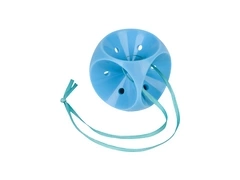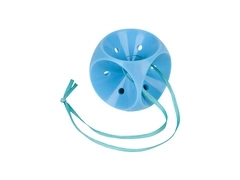Cube pessary
( number of products: 6 )A cube pessary is a popular pessary used to treat urinary incontinence and pelvic organ prolapse in women. It is a flexible silicone or rubber device inserted into the vagina to support the pelvic organs and prevent uncontrolled urine leakage.
A cube pessary can be used temporarily or long-term, depending on your needs and the recommendations of your healthcare professional.
Cube Pessary
The Cube pessary is a specialized vaginal support device designed to provide strong, stable support for women experiencing moderate to severe pelvic organ prolapse (POP). Unlike simpler pessary shapes, the Cube pessary offers multi-surface contact with the vaginal walls, allowing it to stay securely in place even when other pessaries may shift or lose support.
At PelviCare, we offer high-quality medical-grade Cube pessaries in a range of sizes to ensure a precise, comfortable, and effective fit, whether used daily or as part of a structured pelvic floor rehabilitation plan.
When Is a Cube Pessary Recommended?
The Cube pessary is commonly recommended when pelvic organs require more pronounced lifting and stabilization. It is particularly suitable for individuals experiencing:
-
Uterine prolapse (stages II–III)
-
Cystocele (bladder prolapse into the vaginal wall)
-
Rectocele (rectal prolapse into the vaginal wall)
-
Vaginal vault prolapse (after hysterectomy)
-
Feeling of heaviness or pressure in the pelvis
-
Prolapse symptoms that worsen during standing or movement
The Cube pessary can help restore daily comfort, reduce feelings of pelvic pressure, and support engagement in physical activity without worsening symptoms.
How the Cube Pessary Works
The Cube pessary is designed with multiple flat surfaces and edges that create gentle suction-like contact against the vaginal walls. This distributed contact helps:
-
Keep the pessary securely in place, even during movement
-
Lift and support pelvic organs from below
-
Relieve symptoms of heaviness, bulging, and pressure
-
Make standing, walking, and physical activity more comfortable
The structure ensures the pessary remains stable without pressing on one specific tissue point, making it suitable for cases of weakened or lax pelvic walls.
Key Benefits of the Cube Pessary
Women who use the Cube pessary often experience:
-
Immediate reduction of pelvic pressure and bulging sensation
-
Improved comfort when walking, lifting, or exercising
-
Greater freedom of movement and daily confidence
-
Support for postpartum recovery and pelvic floor rehabilitation
-
Non-surgical, reversible symptom management
-
Ability to delay or avoid surgery when appropriate
Unlike disposable support products, a Cube pessary provides structural support, addressing the cause of prolapse symptoms rather than merely masking them.
Daily Use and Self-Management
The Cube pessary is intended for daily insertion and removal. Removal is typically recommended each evening to allow the vaginal tissues time to rest and breathe.
Why daily removal matters:
-
Maintains vaginal tissue health
-
Reduces risk of irritation or dryness
-
Allows for regular cleaning and hygiene
Once a woman is familiar with the insertion and removal process, the Cube pessary can often be self-managed confidently at home, making it a practical long-term support solution.
Insertion and Removal
Insertion:
-
Wash hands thoroughly.
-
Apply a water-based lubricant to the pessary.
-
Gently compress the sides to shape for insertion.
-
Insert into the vaginal canal and position comfortably.
Removal:
-
Hook a finger under one of the cube’s edges or retrieval string, if included.
-
Gently slide downward and remove.
-
Rinse in warm water and mild soap; allow to dry.
For many women, insertion becomes easier with practice — often within just a few days.
Finding the Right Size of a pessar
Cube pessaries are available in multiple sizes to accommodate different anatomies and degrees of prolapse. Proper sizing ensures:
-
Stable support
-
Comfort during movement
-
Easy insertion and removal
-
Optimal symptom relief
A pelvic floor physiotherapist, gynecologist, or urogynecologist can help determine the ideal size. Once fitted, ongoing use is typically straightforward.
When the Cube Pessary Is the Best Choice
The Cube pessary is particularly useful when:
-
Other pessary shapes (e.g., ring or plate) do not stay in place
-
There is significant laxity of the vaginal walls
-
Prolapse symptoms significantly interfere with daily life
-
The individual wishes to avoid or delay surgery
-
Support is needed during exercise or physically active work
It can also be used during rehabilitation programs focused on pelvic floor muscle strengthening, helping relieve symptoms while the muscles regain function.
Comfort and Safety Considerations
To ensure a positive experience, consider the following:
-
Use water-based lubrication to avoid dryness.
-
Remove pessary daily to support tissue health.
-
Monitor comfort levels and adjust size if needed.
-
Consult with a clinician if:
-
Discomfort occurs
-
Vaginal irritation develops
-
Prolapse symptoms change significantly
-
Some individuals may also benefit from vaginal moisturizers or local estrogen therapy, particularly during menopause or breastfeeding, when tissues may be more sensitive.
Cube Pessary and Pelvic Floor Rehabilitation
Using a Cube pessary does not replace pelvic floor muscle training — but it supports rehabilitation by:
-
Reducing symptoms that prevent exercise participation
-
Allowing for greater mobility and activity
-
Supporting tissues while muscles strengthen gradually
Many physiotherapists recommend a pessary as part of a long-term recovery strategy, rather than a last resort.
Who Should Not Use a Cube Pessary?
Pessaries may not be suitable for individuals with:
-
Vaginal infections
-
Significant vaginal discomfort or unexplained pain
-
Difficulty with self-care when daily removal is required
-
Recent pelvic surgery without medical clearance
Consultation with a healthcare professional ensures safe and effective use.






